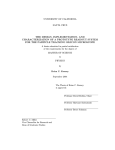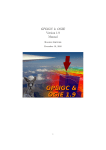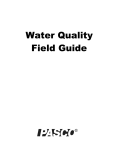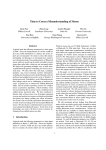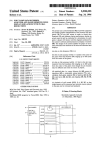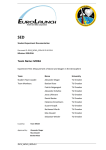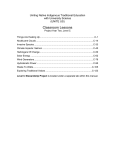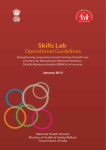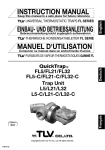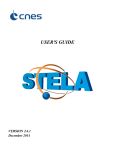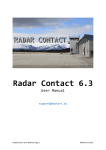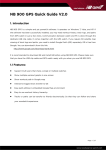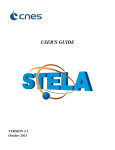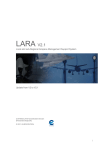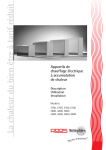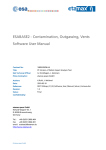Download Chase Blokker, Software Engineer Nicole Klee, Experiment
Transcript
Chase Blokker, Software Engineer Nicole Klee, Experiment Designer Amy Ousterhout, Project Leader Geoffrey Pleiss, Quality Control Graeme Radlo, Equipment Manager Prasanth Veerina, Data Coordinator 4/21/2009 Atmospheric Science Experiments I. Abstract In this experiment, a weather balloon was sent almost 1,000 feet up into the atmosphere carrying several sensors in the hope that interesting properties of the atmosphere could be studied. Three different properties of the atmosphere were measured as a function of altitude: pressure, temperature, and carbon dioxide level. The results suggest that atmospheric pressure can be accurately modeled using the NASA empirical formula or the exponential model. Atmospheric temperatures varied significantly during the course of the experiment, so there was not a clear correlation between the results and the NASA empirical temperature model. Carbon dioxide concentrations decreased slightly as altitude increased, but the appropriate equation to represent this correlation was not apparent from the data. II. Introduction In this study of the atmosphere, data was gathered concerning different aspects of the atmosphere with the use of a weather balloon. The balloon traveled to nearly one thousand feet in the air (details about the specific experiment to follow) but those thousand feet are only part of one layer in the many that make up the atmosphere. The first 10 km of the atmosphere constitute the troposphere, which contains the air we are used to and the airflows that we recognize. Above the troposphere are the stratosphere and mesosphere, which have a ‘nearly frictionless’ air flow. Beyond these are the thermosphere and exosphere (for details on the compositions of the various layers of the atmosphere, see Appendix 4). These different atmospheric layers demonstrate inverse correlations to the air P = P0 (1-h/44329)5.255876 pressures within them; the pressure in higher altitude layers is less than that in lower altitude layers. Figure 1: The empirical Although pressure does not seem to have a direct formula for pressure in the formulaic relationship with altitude, several attempts have been atmosphere as a function of made to model pressure as a function of altitude, the most altitude ‘h’ above a widely accepted of which are the NASA empirical formula and location of known pressure the exponential model. The empirical formula used by NASA ‘P0’, developed by for the study of the atmosphere is calculated based on a averaging large quantities collection of data points gathered by an advanced spectrometer, of data [1]. and is shown in Figure 1. The exponential model is a theoretical model based on the Ideal Gas Law, and is shown in Figure 2 [1]. P = P0 e(-h/8420) These two models allow scientists to approximate altitude based on measurements of pressure (for details on both of these Figure 2: The exponential formulas, see Appendix 3). model for pressure in the However, these maps and charts, especially those for atmosphere as a function of temperature, won’t stay so predictable for long. With processes altitude ‘h’ above a like global warming, in which gases like CO2 are not being location of known pressure absorbed by the trees and are instead trapping themselves in the ‘P0’ [1]. atmosphere, the thicknesses of the various atmospheric layers are changing. The overall number of trees is declining in the world; people keep cutting them down and using them for whatever purpose they deem necessary. So waste gases from such things as cars are not being properly dealt with and instead are being pumped into the atmosphere and trapped there. Once in the atmosphere these gases absorb radiation that would normally exit Earth's atmosphere, and reemit some of it back towards Earth. This process is known as the Greenhouse Effect and causes the atmosphere and Earth's surface to warm up. Because water vapor is a greenhouse gas, and because its concentration in the atmosphere increases as atmospheric temperatures increase, a positive feedback loop is created; the net movement of the system is in one direction, from cooler to warmer. The Earth warms over time because there is no negative feedback to help solve the problem, so the natural tendency of systems toward equilibrium is in danger of breaking down in this case. All this affects the atmosphere, underlining the importance of the type of data the weather balloon experiment was designed to collect. The first step was the compilation of a contour map from 50 different coordinate points spread across a region of the nearby coastal mountains. 22 points were measured on one day and 28 points on another day. At these coordinate points, barometric pressure was measured, as well as the altitude based on the triangulation from the GPS. The authors used the barometric pressure at a known altitude (114 m at the second coordinate point that was looked up on Google Earth) and barometric pressures at the other coordinate points to calculate the altitude at those points. Fifty points were then plotted in 3D space, both for the barometric and GPS altitude readings, with the x and y axes being latitude and longitude and z axis being altitude. This mini-experiment was a test to justify using barometric pressure readings to get altitudes. At the time of the actual experiment the plans changed greatly concerning how often data was to be taken. The original plan of letting out the balloon for a designated time and then stopping it to take data was not as time-efficient as the experiment needed to be. The rope attached to the reel-in system got tangled, so while the balloon was being let out the reel-in string had to be cut loose and then reattached. The LabQuest device was activated simultaneously with a separate timer so that time data could be recorded by the same group that was taking the height data. The balloon with its attached gondola would be let out slowly by hand by one team until the group taking the data signaled them to stop so that they could take a few points by the rangefinder-sextant method. The time at which each point of data was taken was recorded in the data table. Meanwhile, the LabQuest device in the gondola attached to the balloon was running experiments involving a CO2 sensor, a thermometer, and a barometer. This experiment was about finding data for these three things so data points were taken every five seconds for the entire air time, which made the ascent prohibitively slow. The reeling team was then told to continue the balloon’s movement, and this was continued until it was decided that the balloon had gotten high enough to be sufficient (about 950 feet). The reeling team then attached the balloon’s string to the reel-in system and the balloon was continuously reeled back in. When the gondola and balloon reached the ground, both timers were stopped and the data from the LabQuest was immediately transferred and saved in the computer. 2 III. Data Table Table 1 provides a summary of all the data recorded over the course of the experiment. Data taken before 290 seconds had elapsed and after 2170 seconds (until the experiment ended at 2500 seconds) was omitted because the LabQuest was at ground level at these times, and the presence of so many people nearby is believed to have severely distorted the carbon dioxide readings. The relative altitude values were calculated from the barometer readings, using the ground as 0 m of altitude (Pø = average of the first 200 seconds). The temperature error is not listed because, according to the sensor’s manual, it is a constant +/-.2 K [2]. Table 1: Summary Table of Recorded Data and Calculated Values Time Pressure (s) (atm) 290 330 360 420 490 550 610 650 750 870 920 980 1050 1180 1240 1310 1360 1410 1490 1750 1780 1820 1860 1910 1960 2010 2050 2090 2120 2150 2170 1.0048 1.0036 1.0026 1.0015 1.0002 0.99870 0.99580 0.99382 0.99083 0.98755 0.9841 0.9819 0.9802 0.9779 0.9761 0.9746 0.9736 0.9726 0.9703 0.9736 0.9754 0.9782 0.9804 0.9834 0.98746 0.99046 0.99430 0.99654 0.99887 1.0011 1.0027 Barometer Laser Pressure Pressure CO2 Relative Rangefinder CO2 Corrected Temperature Error Error Altitude Altitudes (ppm) CO2 (K) (kPa) (ppm) (m) (m) (ppm) 20.05 30.23 38.02 47.47 58.51 71.07 95.57 112.3 137.6 165.5 195.1 213.6 228.8 248.1 263.5 276.4 285.3 294.2 313.7 285.3 269.9 245.7 226.4 200.7 166.4 140.8 108.3 89.31 69.57 50.62 37.27 19 27 34 45 52 67 88 102 117 154 181 202 214 232 242 252 261 273 289 269 251 231 209 187 151 130 102 82 63 43 32 308 296 299 296 283 280 283 280 271 280 280 274 274 265 253 256 250 250 256 283 280 286 296 299 280 286 296 293 296 293 296 3 309 298 301 299 287 285 289 287 279 290 292 287 288 280 268 272 267 267 274 300 296 301 309 311 290 295 302 298 300 296 298 295.04 294.62 294.20 294.52 293.61 293.31 292.30 293.31 294.71 292.93 291.73 291.25 291.66 291.68 292.96 292.39 292.70 293.26 292.74 294.85 295.06 293.89 293.35 292.70 293.42 293.87 293.87 293.59 293.92 294.27 294.71 0.61 0.61 0.61 0.61 0.61 0.61 0.60 0.60 0.60 0.60 0.60 0.60 0.59 0.59 0.59 0.59 0.59 0.59 0.59 0.59 0.59 0.59 0.60 0.60 0.60 0.60 0.60 0.60 0.61 0.61 0.61 20 19 19 19 18 18 19 18 18 19 19 18 19 18 17 18 17 17 18 19 19 19 20 20 19 19 19 19 19 19 19 IV. Contour Map Mini-Experiment 122.265° W 122.245° W Figure 3: A reference map showing the approximate location of the following contour maps [3]. 37.405° N 37.370° N The data for the contour map mini-experiment was taken in approximately the region shown in Figure 3; the contour maps generated from this data are Figures 4 through 7. The barometer error is .599% (as explained in Appendix 2), so the maximum barometer error is 3.2 meters (at the highest altitude). Temperature varied 10 degrees Celsius while taking the coordinate points. All altitudes are the altitude above sea level in meters. 4 Figure 4: Contour map based off of altitudes calculated from barometric pressure. Figure 5: Contour map based off of GPS altitudes. Many coordinate points are inaccurate due to GPS error (poor signal). 5 Figure 6: 3D contour map based off of altitudes calculated from barometric pressure. Figure 7: 3D contour map based off of GPS altitudes. Many coordinate points are inaccurate due to GPS error (poor signal). 6 V. Graphs from the Main Balloon Experiment Figure 8: Barometric pressure in kPa is plotted against relative altitude (altitude above the school quad) in meters. The altitude was calculated using the laser rangefinder. Not all the pressure data is represented on this graph, because rangefinder readings were only taken about every minute; only the corresponding pressure measurements are included. The error bars were calculated based on inaccuracies of the barometer due to changes in temperature (see Section VII, “Error Bar Sample Calculations”). The data points are curve-fit using NASA's empirical model of atmospheric pressure (P = P0 (1-h/44329)5.255876), darker [1], and the exponential model (P = P0 e(-h/8420)), lighter [4]. [For a color version of this figure, see the online version of the article available at http://roundtable.menloschool.org.] 7 Figure 9: Temperature in K is plotted against relative altitude (altitude above the Menlo quad) in meters. The altitude used in this plot was calculated from the barometric pressure. The data is split into two parts; the darker data points represent the temperature readings taken as the balloon ascended and the lighter data points represent the readings as the balloon was reeled in. [For a color version of this figure, see the online version of the article available at http://roundtable.menloschool.org.] Error bars are a constant +/- .2 K, the accuracy of the sensor (see Section VII, “Error Bar Sample Calculations”). Both data sets were curve fitted using the NASA empirical model for atmospheric temperature (T = T0 (1h/44329)) [1]. The temperature on the descent is clearly higher than the temperature on the ascent; this effect can be attributed to changing weather over the course of the launch. 8 Figure 10: Carbon dioxide in ppm (by volume) is plotted against relative altitude (altitude above the Menlo quad) in meters. The altitude used in this plot was calculated from the barometric pressure. The carbon dioxide values have been corrected for inaccuracies due to low pressures. The data is split into two parts; the darker data points represent CO2 readings taken as the balloon ascended and the lighter data points represent the readings as the balloon was reeled in. [For a color version of this figure, see the online version of the article available at http://roundtable.menloschool.org.] Error bars for both sets were calculated based on random fluctuations in the sensor’s readings and the pressure corrections (see Section VII, “Error Bar Sample Calculations”). Both sets of data were curve fitted using linear fits. VI. Altitude Sample Calculations Altitude Calculated from Pressure The authors used the following formula to calculate relative altitude from pressure (see Appendix 3 for details about this formula) [4]. This calculation was key to both the contour mapping and the balloon experiments: P = P0 e –h/a Solving for h: h = -a ln(P/P0) where the constant a = 8420 m and P0 =1.00716224 atm, which was found by taking the average of the first 200 seconds of pressure data (taken at ground level where the balloon was launched). Thus to calculate the relative altitude, simply take the pressure reading given at any given point (for example at time of 1490 s the authors recorded a pressure of P = 0.9703 atm), and plug that into the equation, as shown below. h = -8420 m ln(P/1.0071 atm) h = -8420 m ln(.9703 atm/1.0071 atm) 9 h = 313.7 m Therefore at time 24:50 (mm:ss) the balloon was ~313.7 m above the Menlo quad. In order to find the absolute altitude all that would be necessary would be to add the altitude of the Menlo quad from sea level onto the calculated altitude. Altitude Calculated Using the Laser Rangefinder The authors also used a laser rangefinder with a sextant to verify and track the balloon’s ascent. In order to calculate the altitude of the balloon from the distance read on the rangefinder, the authors first let the observed distance h be the hypotenuse of a right triangle, then used the sin function to solve for the opposite side (as depicted in Figure 11): sin(θ) = a/h a = h sin(θ) Figure 11: This not-to-scale diagram depicts where θ is the angle at which the the way in which the laser rangefinder was rangefinder is tilted upwards (during the used in conjunction with a sextant to experiment the authors recorded angle x as calculate the altitude of the balloon. shown in the figure; angle x is complementary to θ so the authors calculated θ = 90º - x to find θ). To solve for the altitude at any given point simply plug in the observed distance and the angle of the tilt. For example at time 1050 s the authors observed a distance of 254 yds at an angle θ of 67º: a = 254 yds sin(67º) a ≈ 701 ft Thus the authors were able to monitor the balloon’s progress and have a second set of altitude measurements to plot the pressure readings against. VII. Error Bar Sample Calculations Temperature The error bars for the temperature data were calculated from data found on the sensor’s user manual. The sensor uses a resistor in an electrical circuit to calculate the temperature [5]. Since resistance is affected by temperature, the resistance in the circuit changes as temperature changes. An ammeter can measure this change, which is then used to calculate the change in temperature. Pressure does not affect resistance, so pressure would not affect the temperature reading. Therefore, the error on the sensor would only be due to random fluctuations in the temperature reading, which the user manual claimed to be ±0.2ºC [5]. This was added to each of the temperature readings to calculate the error bars. Pressure For the pressure sensor, the two most logical sources of error were temperature change and random fluctuations in the reading. The error due to the latter was calculated by placing the 10 barometer in a closed container at a constant temperature so that the pressure would not change. The range of the pressure readings was used to calculate the error as seen in the following equation: Range Error = Avg. value The error calculated was 0.05%, and was, for the purpose of this experiment, considered to be negligible. To calculate the error due to temperature, the barometer was placed in a freezer with the temperature probe in a sealed container. As the temperature decreased, so did the barometer reading, which was expected because the ratio of pressure to temperature is constant in a closed container, due to Charles’ law. A linear fit was placed on the graph of pressure as a function of temperature, and the error on the fit (taken from the ± value of the slope) was used to calculate the error bars by multiplying each pressure reading by the error constant (the ± value divided by the slope), which was calculated to be 0.599%. Carbon Dioxide The CO2 sensor had the most potential for error, since its error could be attributed to random fluctuations, pressure changes, and temperature changes. Fluctuations were calculated in a similar manner as for the barometer. (The CO2 reading was measured in a closed container, and the range divided by the average value gave the error due to fluctuations.) The error came out to be roughly 6.17%. To account for a change in pressure, the CO2 sensor and the barometer were placed in a vacuum chamber, and air, after being sucked out, was slowly allowed to leak back in, giving the CO2 sensor readings at various pressures. Since the ratio of CO2 ppm was constant in the air let into the vacuum pump, the reading should have not changed. Yet as pressure decreased, the CO2 sensor reading decreased, showing that the sensor was affected by a changing pressure. A linear fit was applied to the graph of CO2 reading vs. pressure, giving a slope of 4.84. The error on this curve fit was 2.81%. Therefore, to correct for the change in pressure on the weather balloon data, the following equation was used, where B is the actual CO2 ppm level, which is represented in Figure 14 (see Appendix 2) by CO2*, A is the reading from the CO2 sensor, and P0 is standard atmospheric pressure: A final test was done to see how temperature affected the pressure reading by placing the CO2 sensor with a temperature sensor and a barometer in a freezer in a closed container. After error bars and a pressure correction were applied to the CO2 readings, there appeared to be a significant effect on the CO2 sensor as a result of changing temperature. CO2 levels appeared to be much lower than they should have been (see Graph 3 in Appendix 2). However, this effect was only significant at temperatures well below those that were obtained in the actual weather balloon experiment (roughly 10ºC), so a temperature correction was not applied to the data. The error bars for the CO2 data were calculated by multiplying the correct CO2 data by the total calculated error, which was the sum of the error due to fluctuations and the error due to the pressure correction. Figures 12-14 (see Appendix 2) display the results from all the experiments listed above, as well as more equipment error statistics. 11 VIII. Error and Discussion Overall the results of this experiment approximate the expected results. For the contour map mini-experiment, it is difficult to confirm exactly how accurately the pressure readings allowed the altitude to be calculated because there were several inaccuracies. First of all, pressure varies significantly with weather; low pressures indicate storms, while high pressures indicate clear skies. Because coordinate points were taken on two different days with slightly different weather, the difference of barometric pressure from one day to the other was averaged at three coordinate points. This difference, which was found to be 0.56 kPa, was then subtracted from the second day’s data. Therefore, despite differences in weather between the two days, the contour map data from day one should have been roughly consistent with the contour map data from day two. Even so, only three data points were averaged, so the difference due to weather could have been larger. In addition, weather could have varied over the course of one day of measuring, thereby decreasing the consistency of the results. In addition to pressure variations due to weather, the temperature varied significantly, by as much as ten degrees Celsius over the two different days of measurements. For air at a constant altitude, according to the Ideal Gas Law (PV=nRT), changes in temperature can cause changes in pressure. Because temperature was not measured at all data points, the data was not corrected for changes in temperature. In order to determine the validity of using pressure to estimate altitude, the calculated altitudes were compared to those measured by the GPS. At some points they were quite off, sometimes by as much as 100 meters. The GPS altitude measurements probably weren’t very accurate because they require 4 satellites in order to get an accurate reading, and the necessary four satellites were not always present. Although the barometer and GPS did not always agree, the barometer-calculated altitudes were generally consistent with those demonstrated by Gmaps Pedometer [6], a site created by Google which provides an approximate altitude reading for any location, suggesting that pressure can in fact be used to approximate altitude. Systematic error in the main balloon experiment is harder to quantify, but there are several known sources. First, the authors made an error while using the laser rangefinder to calculate the altitude of the balloon. At distances over 150 yards the rangefinder must be set to the >150yds mode, but the authors failed to do so during the experiment. The results of this error are very noticeable; comparing the average difference between the altitude given by the rangefinder and the altitude given by the barometer below 150 yds (average difference of ~5.5m) to above 150 yds (average difference of ~17.5m) it is clear that all laser rangefinder measurements taken above 150 yds are much less accurate. Note also that the method for finding the angle was also very imprecise; the authors estimate that the sextant used was accurate to +/- 2 degrees at best. Such a disparity in angle measure could potentially cause a difference in altitude of several meters. (Simply testing several calculated altitudes with +/- 2 degrees yielded differences in readings of up to +/- 4 meters.) Thus the credibility for the laser rangefinder altitudes is quite low. The altitudes calculated from the barometer readings on the other hand were fairly accurate; the contour map experiment demonstrated that the barometer did not have significant systematic error and in fact matched within a few meters most of the time. One inaccuracy that the barometer faced that the laser rangefinder did not was weather. The authors expect that weather effects did not significantly change the data. This conclusion is drawn once again from the contour mapping project in which several pressure readings were taken at the same locations 12 on different days (therefore different weather), the calculated altitudes of which remained quite similar. For the temperature measurements a large factor was time and weather. The launch was conducted midmorning and took over an hour for the full ascent and descent. Simply by looking at the temperature readings on the ascent compared to the temperature readings on the descent it is clear that the outside temperature had warmed significantly over the course of the morning. Another factor in explaining the fluctuations of the temperature probe may have been whether the probe was in direct sunlight or was facing away from the Sun and in the shadow of the gondola. One way the authors could have better conducted this measurement would have been to add a light sensor next to the temperature probe so they could track when the temperature probe was facing towards or away from the Sun. The carbon dioxide readings seemed to be fairly consistent. The main inaccuracy with these was the carbon dioxide sensor’s high exposure to humans immediately prior to launch. As demonstrated by Figure 10, the carbon dioxide readings were very high at the beginning of the ascent, but decreased rapidly over the first ten or twenty meters. It is believed that, because there were so many people near the sensor during launch, all of whom were breathing out carbon dioxide, the carbon dioxide readings were initially much higher than they should have been. The carbon dioxide sensor takes time to adjust and for new air to flow through it, replacing the carbon dioxide-filled air with normal air, so the readings for the first twenty or thirty meters of altitude are probably much higher than they should have been. Despite these inaccuracies, the data generally matched the expected results. Both curve fits for the pressure vs. altitude graph (Figure 8) approximated atmospheric pressure at ground level to be 100 kPa. Given that atmospheric pressure is 101.325 kPa, that pressure can vary significantly with weather, and that the altitude measurements were only accurate to two significant figures, the pressure vs. altitude results were as accurate as possible. The pressure vs. altitude data was extremely consistent; the error on the curve fits was less than 0.1%, and every single error bar intersected both curves. These results also demonstrate that both the exponential model and NASA’s empirical formula accurately model pressures at varying altitudes, while the fact that the two curves were essentially identical Molar Mass of Most Common demonstrates how closely empirical data matches theory Gases in the Atmosphere for pressures in the atmosphere. Molar Gas The temperature data was the least consistent of Mass the three sets; not only did the readings vary significantly Carbon Dioxide CO2 44.01 between the ascent and descent, but they fluctuated Argon Ar 39.95 wildly throughout both the ascent and descent. Therefore, Oxygen O2 32.00 the NASA empirical model for temperatures does not seem to accurately reflect the data, as demonstrated by Nitrogen N2 28.01 the fact that, in Figure 9, very few of the error bars Neon Ne 20.18 intersect their respective best-fit curves. However, it is Water Vapor H2 O 18.02 possible that, if the error bars were to take into account the unquantifiable errors discussed above, they would in Methane CH4 16.04 fact intersect the best fit curves; it is still possible that the Helium He 4.00 NASA empirical model is the best curve fit for this data. Table 2: This chart lists the most For the carbon dioxide vs. altitude graph (Figure common gases in Earth's 10), it is difficult to predict exactly what the results atmosphere and their molar masses should look like. One might expect the best fit curve to [7]. 13 simply be a constant, because carbon dioxide concentration measured as a fraction of total air (ppm by volume) should remain constant as pressure changes. However, it is also possible that, as altitude increases, the concentration of carbon dioxide in the atmosphere decreases because it is heavier than most other common gases and therefore is more attracted to the Earth, causing it to sink. Most of the atmosphere is made up of nitrogen and oxygen, which have molar masses of 28.01 grams/mole and 32.00 grams/mole respectively (as shown in Table 2), as compared to carbon dioxide, which has a much larger molar mass of 44.01 grams/mole. This could explain why both the ascent and descent data demonstrate decreases in carbon dioxide concentration as altitude increases. Both halves of the data were fit with linear curves to demonstrate that they are in fact downward-sloping, but this relationship is not necessarily linear; the data was insufficient to predict exactly what this relationship might be. IX. Conclusion Overall this experiment went fairly well. The contour map mini-experiment demonstrated the validity of using the barometer to estimate altitude, the main balloon experiment pressure data very closely matched expected results, and the results of the temperature and carbon dioxide experiments make sense given the numerous opportunities for error. For further research, it would be interesting to send up several balloons, either simultaneously or under varying weather conditions and times of day, to collect large amounts of data. It could then be determined how much the recorded values of pressure, temperature, and carbon dioxide really do fluctuate with varying conditions. The data could also be averaged to look for clearer trends, which would be particularly interesting for the carbon dioxide, because a clear carbon dioxide concentration vs. altitude relationship was not apparent from our results. In addition, it would also be interesting to raise one balloon up in the morning and let it remain at an altitude of approximately 1000 feet for the entire day (or to raise several balloons up at regular height intervals) to examine how pressure, temperature, and carbon dioxide change in the atmosphere over the course of a day. In addition to atmospheric sciences, this project was also an interesting experiment in collaboration. Dividing tasks up evenly among six people and working together to complete all components by a specific deadline is not always easy. However, the authors of this experiment did a fairly good job communicating with one another. The most important deadlines on the To Do Lists (see Appendix 6) were met, information and data were successfully communicated between the various group members, and ultimately the actual experiment was performed with only minor complications, providing reasonable results. X. Appendix 1: Experiment Protocol Sheet 1. Just before we start the beginning process of our experiment, Geoffrey will calibrate the CO2 sensor and the end of the reel-in string will be attached to the strings on the bottom of the gondola. 2. The sensors are previously placed into our gondola (each in their designated place) and are connected to the same LabQuest, which at the moment is turned on. We will make sure that all the sensors are on, everything is secure in its position and hopefully the weather will not be detrimental to the data taking. 14 3. The balloon is ready for lift off (it has been inflated and is attached to its ring and cart) as we have someone in place with a rangefinder and a sextant. 4. The balloon is released and the LabQuest is started. It will be gathering data every five seconds. 5. Person A with a timer will also be standing by and every sixty seconds we will stop the upward movement of the balloon. 6. The balloon will be stopped for 30 seconds and the height will be found by using the data from the rangefinder and the sextant held by person B. 7. Person C will be calculating its height as we are taking data so that we will be able to know when the balloon reaches a thousand feet. 8. Eventually the balloon will reach 1000 feet and when it is being reeled back it will also be stopped every sixty seconds for thirty seconds to have data on its height taken. XI. Appendix 2: Specifications of Equipment Used Laser Rangefinder Instructions: • Turn on the laser rangefinder by pressing the red power button. • Look through the rangefinder as if it is a pair of binoculars and point the cross hairs at the target object. • The distance the object is away from the rangefinder will appear at the top of the display followed by a unit (yards or meters). • To change the unit of measurement, press and hold the mode button for five seconds • In order to change the overall mode of the rangefinder, press the mode button. There are four different modes. - The first mode is standard. Standard mode will be indicated by a lack of mode description under the crosshairs within the display. Use standard mode for a normal target. ‐ The second mode is rain mode, indicated by “RAIN” under the crosshairs within the display. Use RAIN mode when there is any form of precipitation in front of the target object. ‐ The third mode is reflection mode, indicated by “REFL” under the crosshairs within the display. Use this mode when the target object is particularly reflective. ‐ The fourth mode is called “greater than 150 yards” mode, indicated by “>150” under the crosshairs within the display. Use this mode when targeting an object that is more than 150 yards away through other objects (such as bushes) that are closer than 150 yards. Temperature Sensor Instructions: • Plug the temperature sensor into one of the analog ports of the LabQuest. • The sensor should automatically appear on the screen. - If it doesn’t automatically appear in the sensors menu, select sensor setup. Under the CH(x) drop down menu, select “Temperature” “Surface Temperature Sensor.” Then click OK. 15 - If the units are not in ºC, then click the temperature reading on the screen, select “Change Units” “ºC.” • The sensor should be calibrated and ready for use after this. Specifications: • Company: Vernier • Part number: STS-BTA • Range: -25ºC to 125ºC [5] • Accuracy: ±0.2ºC [5] Barometer Instructions: • Plug the barometer into one of the analog ports of the LabQuest. • The sensor should automatically appear on the screen. - If it doesn’t automatically appear in the sensors menu, select sensor setup. Under the CH(x) drop down menu (x being the port the sensor was plugged into), select “Barometer.” Then click OK. - If the units are not in kPa, click the barometer reading on the screen, then select “Change Units” “kPa.” • The sensor should be calibrated and ready for use after this. Figure 12: Barometer reading at a varying temperature. Accuracy reading was the error of the best fit line placed over the data. 16 Specifications: • Company: Vernier • Part number: BAR-BTA • Range: 82 to 106 kPa [2] • Accuracy at STP: ±0.05% • Accuracy under changing temperature: ±0.599% CO2 Sensor Instructions: • Plug the CO2 sensor into one of the analog ports of the LabQuest. • The sensor should automatically appear on the screen. - If it doesn’t automatically appear in the sensors menu, select sensor setup. Under the CH(x) drop down menu, select “CO2 Gas” “CO2 Gas Low.” Make sure on the sensor itself that the switch is also on “CO2 Gas Low.” (Note that low setting was used in the experiment because CO2 levels were assumed to be well within low range). Then on the LabQuest, click OK. - If the units are not in ppm, click the CO2 reading on the screen, select “Change Units” “ppm.” • If after 90 s the reading is not at about 400ppm ± 50ppm, bring the Nalgene bottle that came with the sensor outside, and let it fill with air from the outside. Attach the sensor to the Nalgene bottle with the rubber stopper provided, and click the “calibrate” button on the sensor. After 90 s, the sensor should be calibrated, and then it can be removed Figure 13: CO2 reading with varying pressure. CO2 reading should have remained constant, but data showed an obvious increase with varying pressure. Linear fit was used to find a correction formula for the CO2 reading. 17 from the Nalgene. Specifications: • Company: Vernier • Part number: CO2-BTA • Range: 0 to 10,000 ppm (on low setting, which was used in experiment) [8] • Accuracy at STP: ±6.17% • Correction function for pressure: • Temperature range (for accurate readings): 13ºC to 25ºC Figure 14: CO2 reading (actual reading in red, corrected pressure in green) vs. temperature. [For a color version of this figure, see the online version of the article available at http://roundtable.menloschool.org.] There is an obvious effect on the sensor, but between 10ºC to 25ºC (range of experiment), effect is negligible, and so adjustments weren’t made. Spike at about 16ºC was most likely due to a random fluctuation. 18 XII. Appendix 3: The NASA and Exponential Models of Pressure NASA has created an empirical Flight model for Earth’s atmosphere named the Pressure level Temperature NRLMSISE-00 model. This model hPa °C measures temperature, overall density, 1013 15 and specific gas densities (O2, N2, H, Ar, He) over time at specific xyz coordinates 1000 14.3 in the atmosphere. It is mostly focused 950 11.5 on taking data from altitude ranges of 0 900 8.6 to150 km. Data for this model is 850 A050 5.5 generated by mass spectrometers, thermometers, and barometers that are 800 2.3 located on satellites and rocket probes 750 -1 [9]. A mass spectrometer is a device 700 A100 -4.6 used to measure the mass of principal 650 -8.3 elements found in a sample. One can find the density of that element in the 600 FL140 -12.3 atmosphere by knowing the mass of an 550 -16.6 element, the air pressure, and the 500 FL185 -21.2 temperature through this equation [10]: 450 400 350 FL235 Air density Altitude kg/m³ feet 1.225 msl 1.212 364 1.163 1773 1.113 3243 1.063 4781 1.012 6394 0.96 8091 0.908 9882 0.855 11 780 0.802 13 801 0.747 15 962 0.692 18 289 -26.2 0.635 20 812 -31.7 0.577 23 574 -37.7 0.518 26 631 Where p = density (g · cm−3 ), M = 300 FL300 -44.5 0.457 30 065 molar mass (g · mol −1 ), P = pressure (bar), T = absolute temperature (K), R = 250 FL340 -52.3 0.395 33 999 ideal gas constant (cm3·bar ·mol −1·K −1). 200 FL385 -56.5 0.322 38 662 An example of such data is shown in 150 FL445 -56.5 0.241 44 647 Table 3. This data was found in 100 -56.5 0.161 53 083 correspondence with pressure, meaning that the variables were temperature, air Table 3: This table shows data collected by the density, and altitude while how often International Standard Atmosphere. Temperature, data for these things was recorded air density, and altitude were measured at various depended on pressure. According to this pressures [11]. chart, then, pressure seems not to have a direct formulaic relationship with altitude although pressure on a system can be estimated through how much air is above it and the weight of air. The exact equation is [12]: The relationship between these two units of measurement is exponential. Total Pressure on a system can then be estimated by knowing how much air is above the system and how much this air (in our atmosphere 78% nitrogen, 21% oxygen and 1% trace gases) weighs. 19 Figure 15 is a graph of the NRLMSISE-00 standard model with total atmosphere density and temperature plotted over altitude [13]. The total density decreases exponentially (notice the y axis is logarithmic) as altitude increases. This compares closely with the exponential model that states that pressure decreases exponentially as altitude increases, as Figure 15: This graph demonstrates the NRL-MSISE-00 standard given in the equation model for both atmosphere mass density and temperature [13]. above. Because density varies directly with pressure, as mass density goes down, pressure goes down as well. This is why we saw a decrease in pressure that was measured by our barometer as altitude increases. Temperature varies from day to day as well as at different atmospheric altitudes, which affects the mass density and pressure. XIII. Appendix 4: The Composition of Earth’s Composition of Earth's Atmosphere Atmosphere At Sea Level (of dry air) Earth’s atmosphere is simply a layer of gases Percent by surrounding the planet, held in by Earth’s gravity. As Component Volume demonstrated by Table 4, Earth’s atmosphere is Nitrogen N2 78.08% composed primarily of nitrogen and oxygen, but also Oxygen O 20.95% 2 contains significant amounts of argon, carbon dioxide, neon, helium, methane, and krypton. Earth’s Argon Ar 0.93% atmosphere as a whole is also about 0.4% water vapor, Carbon Dioxide CO2 0.04% but this varies significantly with altitude and weather; Neon Ne 0.002% near the Earth’s surface, water vapor makes up about 1Helium He < 0.001% 4% of air. However, Earth’s atmosphere has not always Methane CH4 < 0.001% been the same; the current atmosphere is usually Krypton Kr < 0.001% considered to be Earth’s third atmosphere. The first Table 4: This chart shows the atmosphere was composed primarily of helium and primary components of Earth's hydrogen, which dissipated as the Earth cooled. The atmosphere near sea level, and their second atmosphere, made of carbon dioxide, water percent abundance by volume, vapor, and nitrogen, formed from the countless assuming that there is no water volcanoes on Earth’s surface about 4.4 billion years ago. vapor in the air [7]. As bacteria and other small organisms became more and more abundant between 3.3 and 2.2 billion years ago, they sequestered carbon into solid forms (such as organic molecules and limestone) while simultaneously releasing oxygen into the 20 atmosphere, causing carbon dioxide levels to decrease and oxygen levels to increase. Aside from human interference, Earth’s atmosphere appears to be fairly stable right now. Although Earth’s atmosphere is constant over time, it is not constant at all altitudes. Figure 16 shows the four bottommost sections of the atmosphere and how temperature differs among them. The lowest layer is the troposphere, which extends from sea level to about 7-17 km (the tropopause) at the poles and the equator, respectively. The composition of the troposphere is generally constant for all altitudes, and corresponds to that of air at sea level. The only component of the atmosphere whose concentration varies significantly in the troposphere is water vapor. For all air, there is a saturation temperature below which water vapor will condense and fall out of the air (as rain), and therefore also a maximum amount of water vapor that the air can hold. Air at colder Figure 16: This diagram shows the four major temperatures or with lower pressures can sections of the atmosphere and how hold less water vapor than air at higher temperature varies between them [14]. temperatures or with higher pressures. Therefore, as altitude increases in the troposphere and both temperature and pressure decrease significantly, the concentration of water vapor also decreases rapidly [15]. In fact, above the tropopause there is essentially no water vapor at all; this is why most clouds and other components of weather exist only in the lower 10 km of the atmosphere, and why the cruising altitude of large commercial airplanes is about 35,000 feet (10.7 km), so that they fly just over most storms [16]. The second layer of the atmosphere is the stratosphere, which extends from about 10 to 50 km. The tropopause, which separates the troposphere and stratosphere, is located at the place where temperature changes from decreasing to increasing. Temperature increases throughout the stratosphere as altitude increases, because of the high concentrations of ozone. Ozone is most abundant in the stratosphere, and absorbs most ultraviolet (UV) light that enters the Earth’s atmosphere. Incident UV rays split up O2 (oxygen gas) or O3 (ozone), producing a combination of O (atomic oxygen) and O2, and increasing the energy (and therefore temperature) of the stratosphere [17]. The third layer of the atmosphere, separated from the stratosphere by the stratopause, is the mesosphere. The mesosphere is where most meteors burn up, because it is the highest altitude at which the concentration of gas particles is high enough for there to be frequent collisions between falling objects and gas particles; these collisions generate a huge amount of heat, which vaporizes most meteors before they can hit the Earth. Because millions of small meteors are vaporized in the mesosphere every day, the mesosphere contains high concentrations of metals such as iron [18]. 21 The Layers of Earth's Atmosphere and their Important Characteristics Altitude Temperature Layer Important Components or Characteristics (km) (°C) contains mainly the lightest gases n/a (essentially Exosphere 650-10,000 (hydrogen, helium), also contains satellites a vacuum) and space debris almost a complete vacuum, includes the Thermosphere 80-640 increasing ionosphere Mesopause 80 -90 Mesosphere 50-80 decreasing Stratopause 50 -3 lowest atmospheric temperature meteors result in high concentrations of metals local maximum of temperature Stratosphere 10-50 increasing maximum concentrations of ozone Tropopause 10 -55 altitude at which airplanes fly Troposphere 0-10 decreasing all the atmosphere's water vapor Table 5: This table lists the major layers of Earth's atmosphere and summarizes their main features, including altitude, temperature, and notable components. The fourth layer of the atmosphere is the thermosphere, and is most significant because it includes the ionosphere. In the ionosphere solar radiation ionizes particles, causing them to reflect radio waves. This is important to amateur radio users, who can bounce their radio waves off the ionosphere and transmit them for much longer distances than they could otherwise. Because the thermosphere is at such a high altitude, it contains very little matter and is almost a vacuum [19]. The thermosphere is also where charged particles from the Sun collide with oxygen and nitrogen atoms, causing these atoms to release electromagnetic rays in the visible range, resulting in the aurora borealis (the Northern Lights) and the aurora australis (the Southern Lights) [20]. Above the atmosphere is the exosphere, which extends up to the official border between the atmosphere and outer space. It contains only the lightest gases, such as hydrogen and helium, as well as small concentrations of oxygen and carbon dioxide. This is also where most satellites orbit the Earth, and as a result it contains increasing amounts of space debris, man-made things that have fallen off of various spacecraft [21]. Table 5 above summarizes the key characteristics of each layer of the atmosphere. XIV. Appendix 5: The Motor Controlled Reel-in System In Figure 17 on the following page, the red indicates the motor. [For a color version of this figure, see the online version of the article available at http://roundtable.menloschool.org.] The base of the motor was attached to the yellow block of wood with four screws, which were long enough to secure the motor to the yellow block of wood and the yellow block of wood to the green base wood. The green base wood was then screwed into the blue piece of wood in four locations as well. The motor was powered with two heavy duty six-volt batteries hooked up in series (not pictured) and could spin in both directions by switching the polarity of the batteries. The grayish rod is the PVC axle that is attached to the motor on one end and is fitted through a 22 Figure 17: This is a scaled diagram of the motor controlled reel-in system that was used in the experiment. All dimensions are labeled in inches. bearing that is held in the purple piece of wood. The purple piece of wood was glued with epoxy to the green base wood. Although it is not pictured in the drawing, the string would be affixed to the center of the grayish purple axle and evenly wrapped around it. It is important that the string is wound with even radii. During our launch, the string was wrapped unevenly, with more string around the center of the axle and progressively less as you get wider. As the balloon was launched, the string tangled around itself and had to be removed. XV. Appendix 6: To Do Lists The following two To Do Lists were used to keep all group members informed and on schedule. Table 6 was distributed on November 10; Table 7 was distributed on November 18. Table 6: C Block Team B - To Do List 1 Tasks are listed in order of priority (complete uppermost tasks first). Please let me know if a completion date seems too soon so that I can revise the schedule Last Updated: Monday, November 10, 2008 Amy (Project Leader) Task Complete Before Group Meeting: CO2 and CO?, distribute To Do Lists, who wants to build the Gondola (ED and/or DC?) 11/12 ask Dr. D about protocol and data sheets talk to SE and DC about contour map retrieve sensors from Dr. D (carbon dioxide and carbon monoxide) organize and coordinate tasks 23 11/12 11/12 11/12 Chase (Software Engineer) Geoffrey (Quality Control) Graeme (Equipment Manager) working with DC, read the "Barometer as an Altimeter" link on Dr. Dann's website. Also includes "Making an Altitude . . . ". 4 pages total. 11/12 working with DC, plan out how you will perform the contour map mini experiment: where/how often will you take altitude readings? What data tables do you need? 11/12 working with DC, collect data for the contour map (drive up to Skyline, taking pressure measurements at 50 ft. elevation change intervals) 11/14 complete contour map TBA write a brief explanation of the contour map to include in the introduction of the paper TBA work with DC to create all graphs and figure captions for the final paper TBA work with EM to create instruction sheets for the carbon dioxide and carbon monoxide measuring devices 11/12 work with EM to create instruction sheets for the laser rangefinder (for altitude calibration) and the pressure and temperature sensors 11/14 design experiments to test the accuracy of all equipment/probes check over the protocol and data sheets created by ED 11/14 TBA complete experiments to test the accuracy of all equipment/probes and report results to EM TBA determine how temperature affects the pressure reading (see "Atmospheric Science Experiments" description) TBA work with EM to create Appendix 2 (spec sheets on all equipment used) TBA work with QC to create instruction sheets for the carbon dioxide and carbon monoxide measuring devices 11/12 work with QC to create instruction sheets for the laser rangefinder (for altitude calibration) and the pressure and temperature sensors 11/14 design the motor controlled reel-in system (including a rough sketch and list of materials) 11/14 build the motor controlled reel-in system test the motor controlled reel-in system create a sketchup drawing of the reel-in system 11/19 11/21 TBA 24 Nicole (Experiment Designer) Prasanth (Data Coordinator) work with QC to create Appendix 2 for the paper (spec sheets on all equipment used) TBA create a protocol sheet for the experiment and data sheets for the field work, give to QC to be checked (I'm not exactly sure what these are - we can ask Dr. D on Tuesday) 11/14 organize, type, and complete Appendix 1 (experiment protocol sheets and data gathering sheets) TBA working with SE, read the "Barometer as an Altimeter" link on Dr. Dann's website. Also includes "Making an Altitude . . . ". 4 pages total. 11/12 working with SE, plan out how you will perform the contour map mini experiment: where/how often will you take altitude readings? What data tables do you need? 11/12 working with SE, collect data for the Contour map (drive up to skyline, taking pressure measurements at 50 ft. elevation change intervals) 11/14 collect and organize all data from experiment into a data table for the final paper, check for consistency, accuracy, etc. TBA work with SE to create all graphs and figure captions for the final paper TBA writes error and accuracy discussion section for final paper (including statistical and systematic errors) TBA Other Miscellaneous Tasks create a design for the gondola, including a sketch and materials list (work with EM to make sure all data sensors are included and that it can connect to the reel system) 11/19 build the gondola 11/19 Miscellaneous Final Paper Tasks (see rubric) Research the introductory material - atmosphere and greenhouse effect and write it up Write up the explanation of pressure and temperature models (intro) Explain how the experiments were carried out (intro) Sample Calculations Conclusion Bibliography and Citations 25 Appendix 3 (comparison of NASA and exponential models) Appendix 4 (table comparing atmospheric composition vs. altitude) Table 7: C Block Team B - To Do List 2 ASAP denotes tasks that MUST be completed before the launch date (11/21) Last Updated: Tuesday, November 18, 2008 Important Notes for Everyone Please e-mail all components of the final paper to PL - [email protected] - before Sunday 11/23 (assuming that the paper is due before Thanksgiving). This will allow enough time for revisions. When you use outside sources throughout the paper, put the source information in parentheses at the end of the sentence. I will compile all sources and complete the bibliography and citations. If the source is a website, just give the URL, otherwise provide all necessary info. Submit any receipts for purchased items to PL by 11/21. I distributed out the components of the final paper as seemed logical. Please let me know if you feel that you have too much work, not enough information to write your portions, or are unclear as to what your components entail. Amy (Project Leader) Chase (Software Engineer) Task Complete Before hand out to-do lists 11/20 ask Dr. D about Appendix 4, and assign it to someone 11/20 organize and coordinate tasks - check protocol sheet, motor controlled reel-in system, and gondola (also contour map progress and QC experiments) 11/23 work with QC on QC experiments 11/23 write the conclusion and bibliography and citations 11/23 compile and read the paper's components, e-mail to everyone for revisions 11/24 complete contour map 11/23 write a brief explanation of the contour map to include in the introduction of the paper 11/23 work with DC to create all graphs and figure captions for the final paper 11/23 write Appendix 3 for the final paper (comparison of NASA and exponential models) 11/23 26 Geoffrey (Quality Control) Graeme (Equipment Manager) Nicole (Experiment Designer) Prasanth (Data Coordinator) check over the protocol and data sheets created by ED ASAP complete experiments to test the accuracy of all equipment/probes and report results to EM 11/23 determine how temperature affects the pressure reading (see "Atmospheric Science Experiments" description) 11/23 work with EM to create Appendix 2 (spec sheets on all equipment used) 11/23 submit typed instruction sheets of all equipment to PL and ED build the motor controlled reel-in system test the motor controlled reel-in system create a sketchup drawing of the reel-in system ASAP ASAP ASAP 11/23 work with QC to create Appendix 2 for the paper (spec sheets on all equipment used) 11/23 complete final protocol sheet, including detailed instructions of how to turn on/use all sensors and probes, as necessary. (do any sensors need to be calibrated?) submit to all group members for approval and revise as necessary ASAP finish building the gondola and securing all probes and sensors organize, type, and complete Appendix 1 (experiment protocol sheet) ASAP 11/23 research and write the introduction for the final paper 11/23 collect and organize all data from experiment into a data table for the final paper, check for consistency, accuracy, etc. 11/23 work with SE to create all graphs and figure captions for the final paper write the sample calculation section of the final paper 11/23 11/23 write the error and accuracy discussion section for final paper (including statistical and systematic errors) 11/23 XVI. Bibliography [1] “Knowledge about our Atmosphere and Mathematical Models of its Behaviour,” http://scipp.ucsc.edu/outreach/balloon/index.html. [2] “Barometer BAR-BTA Technical Information,” Vernier. http://www.vernier.com/probes/barbta.html (accessed 25 November 2008). 27 [3] Google Maps, http://maps.google.com/maps?hl=en&tab=wl. [4] “Using the Barometer as an Altimeter,” http://nova.menloschool.org/~jdann/ASR/Atm%20Science/Barometer%20as%20Altimeter.p df. [5] “Surface Temperature Sensor STS-BTA Technical Information,” Vernier. http://www.vernier.com/probes/sts-bta.html (accessed 25 November 2008). [6] Gmaps Pedometer, http://www.gmap-pedometer.com. [7] Table 5.4, Atmospheric Composition near Sea Level, Chemistry, by Steven Zumdahl, 2007, page 211. [8] “CO2 Gas Sensor CO2-BTA Technical Information,” Vernier. http://www.vernier.com/probes/co2-bta.html (accessed 25 November 2008). [9] “Atmosphere and Ionosphere models,” http://www.spenvis.oma.be/spenvis/help/background/atmosphere/models.html. [10] “Density,” http://en.wikipedia.org/wiki/Density. [11] “Meteorology,” http://www.pilotfriend.com/av_weather/meteo/atmos.htm. [12] “Atmospheric Pressure,” http://en.wikipedia.org/wiki/Atmospheric_pressure. [13] “NRLMSISE-00,” http://en.wikipedia.org/wiki/NRLMSISE-00. [14] The Atmosphere, by Lutgens and Tarbuck, page 18. Available from “The Atmosphere,” http://www.ux1.eiu.edu/~cfjps/1400/atmos_struct.html. [15] “Troposphere,” http://en.wikipedia.org/wiki/Troposphere. [16] Mark Abruzzese, Environmental Science Class, 2008. [17] “Ozone,” http://en.wikipedia.org/wiki/Ozone#Ozone_in_Earth.27s_atmosphere. [18] “Mesosphere,” http://en.wikipedia.org/wiki/Mesosphere. [19] “Thermosphere,” http://en.wikipedia.org/wiki/Thermosphere. [20] “How does the aurora borealis (the Northern Lights) work?” http://science.howstuffworks.com/question471.htm. [21] “Exosphere,” http://en.wikipedia.org/wiki/Exosphere. XVII. Acknowledgements Thanks to Dr. Dann for assisting with various problems throughout this project, most notably the reel-in system complication on launch day. 28




























